Potřebujeme váš souhlas k využití jednotlivých dat, aby se vám mimo jiné mohly ukazovat informace týkající se vašich zájmů. Souhlas udělíte kliknutím na tlačítko „OK“.
ASTM D4684-14
Standard Test Method for Determination of Yield Stress and Apparent Viscosity of Engine Oils at Low Temperature
Automaticky přeložený název:
Standardní zkušební metoda pro stanovení meze kluzu a zdánlivá viskozita oleje motoru při nízké teplotě
NORMA vydána dne 1.7.2014
Informace o normě:
Označení normy: ASTM D4684-14
Poznámka: NEPLATNÁ
Datum vydání normy: 1.7.2014
Kód zboží: NS-28156
Počet stran: 14
Přibližná hmotnost: 42 g (0.09 liber)
Země: Americká technická norma
Kategorie: Technické normy ASTM
Kategorie - podobné normy:
Anotace textu normy ASTM D4684-14 :
Keywords:
low temperature flow properties, low temperature viscosity, mini-rotary viscometer, pumping viscosity, used diesel engine oil, viscosity, yield stress, ICS Number Code 75.100 (Lubricants, industrial oils and related products)
Doplňující informace
| Significance and Use | ||||||||||||||
|
5.1 When an engine oil is cooled, the rate and duration of cooling can affect its yield stress and viscosity. In this laboratory test, a fresh engine oil is slowly cooled through a temperature range where wax crystallization is known to occur, followed by relatively rapid cooling to the final test temperature. These laboratory test results have predicted as failures the known engine oils that have failed in the field because of lack of oil pumpability.4 These documented field failing oils all consisted of oils normally tested at –25 °C. These field failures are believed to be the result of the oil forming a gel structure that results in either excessive yield stress or viscosity of the engine oil, or both. 5.2 Cooling Profiles: 5.2.1 For oils to be tested at −20 °C or colder, Table X1.1 applies. The cooling profile described in Table X1.1 is based on the viscosity properties of the ASTM Pumpability Reference Oils (PRO). This series of oils includes oils with normal low-temperature flow properties and oils that have been associated with low-temperature pumpability problems 5.2.2 For oils to be tested at −15 °C or −10 °C, Table X1.2 applies. No significance has been determined for this temperature profile because of the absence of appropriate reference oils. Similarly, precision of the test method using this profile for the −10 °C test temperature is unknown. The temperature profile of Table X1.2 is derived from the one in Table X1.1 and has been moved up in temperature, relative to Table X1.1, in consideration of the expected higher cloud points of the viscous oils tested at −15 °C and −10 °C. |
||||||||||||||
| 1. Scope | ||||||||||||||
|
1.1 This test method covers the measurement of the yield stress and viscosity of engine oils after cooling at controlled rates over a period exceeding 45 h to a final test temperature between –10 °C and –40 °C. The precision is stated for test temperatures from –40 °C to –15 °C. The viscosity measurements are made at a shear stress of 525 Pa over a shear rate of 0.4 s–1to 15 s–1. The viscosity as measured at this shear stress was found to produce the best correlation between the temperature at which the viscosity reached a critical value and borderline pumping failure temperature in engines. 1.2 This test method contain two procedures: Procedure A incorporates several equipment and procedural modifications from Test Method D4684–02 that have shown to improve the precision of the test, while Procedure B is unchanged from Test Method D4684–02. Additionally, Procedure A applies to those instruments that utilize thermoelectric cooling technology or direct refrigeration technology of recent manufacture for instrument temperature control. Procedure B can use the same instruments used in Procedure A or those cooled by circulating methanol. 1.3 Procedure A of this test method has precision stated for a yield range from less than 35 Pa to 210 Pa and apparent viscosity range from 4300 mPa·s to 270 000 mPa·s. The test procedure can determine higher yield stress and viscosity levels. 1.4 This test method is applicable for unused oils, sometimes referred to as fresh oils, designed for both light duty and heavy duty engine applications. It also has been shown to be suitable for used diesel and gasoline engine oils. The applicability to petroleum products other than engine oils has not been determined. 1.5 The values stated in SI units are to be regarded as standard. No other units of measurement are included in this standard. 1.5.1 Exception—This test method uses the SI based unit of milliPascal second (mPa·s) for viscosity which is equivalent to, centiPoise (cP). 1.6 This standard does not purport to address all of the safety concerns, if any, associated with its use. It is the responsibility of the user of this standard to establish appropriate safety and health practices and determine the applicability of regulatory limitations prior to use. |
||||||||||||||
| 2. Referenced Documents | ||||||||||||||
|
Podobné normy:
Historická
1.5.2014
Historická
1.5.2011
Historická
15.10.2008
Historická
1.10.2009
Historická
1.1.2012
Historická
1.5.2014


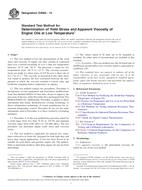
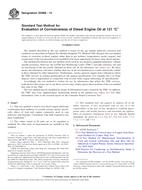 ASTM D5968-14
ASTM D5968-14 ASTM D5969-11e1
ASTM D5969-11e1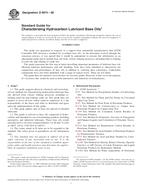 ASTM D6074-08
ASTM D6074-08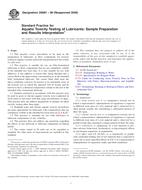 ASTM D6081-98(2009)..
ASTM D6081-98(2009)..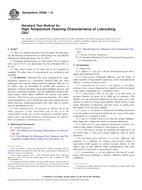 ASTM D6082-12
ASTM D6082-12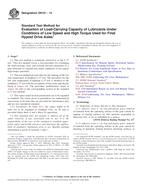 ASTM D6121-14
ASTM D6121-14
 Cookies
Cookies
